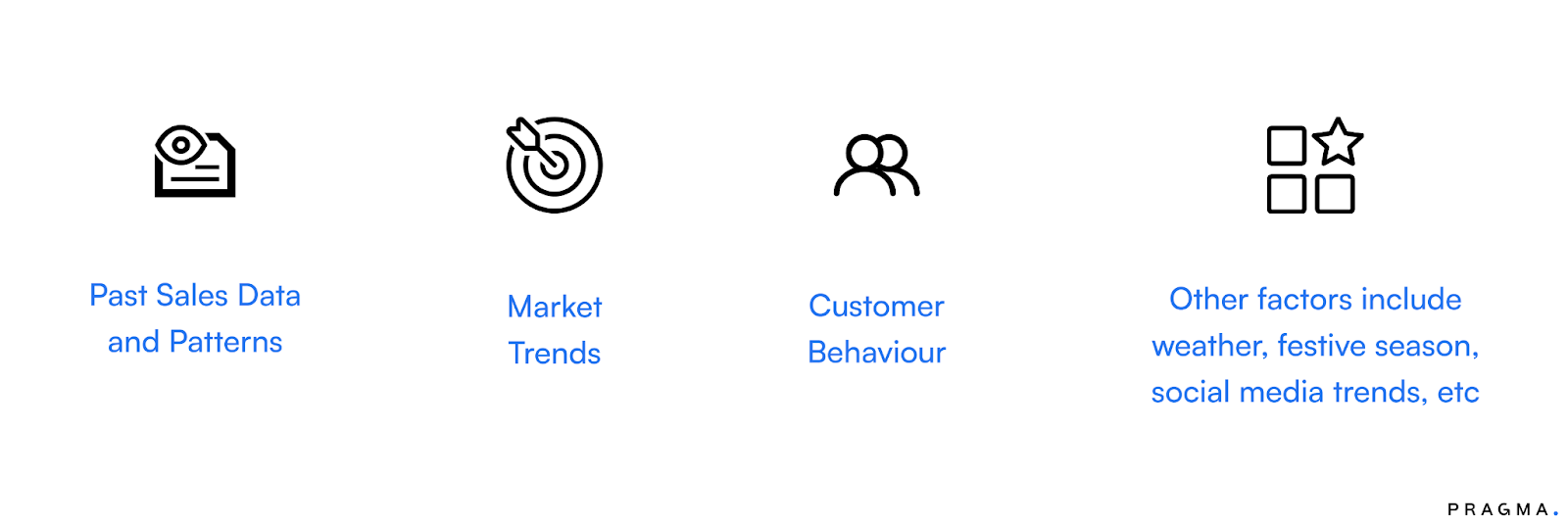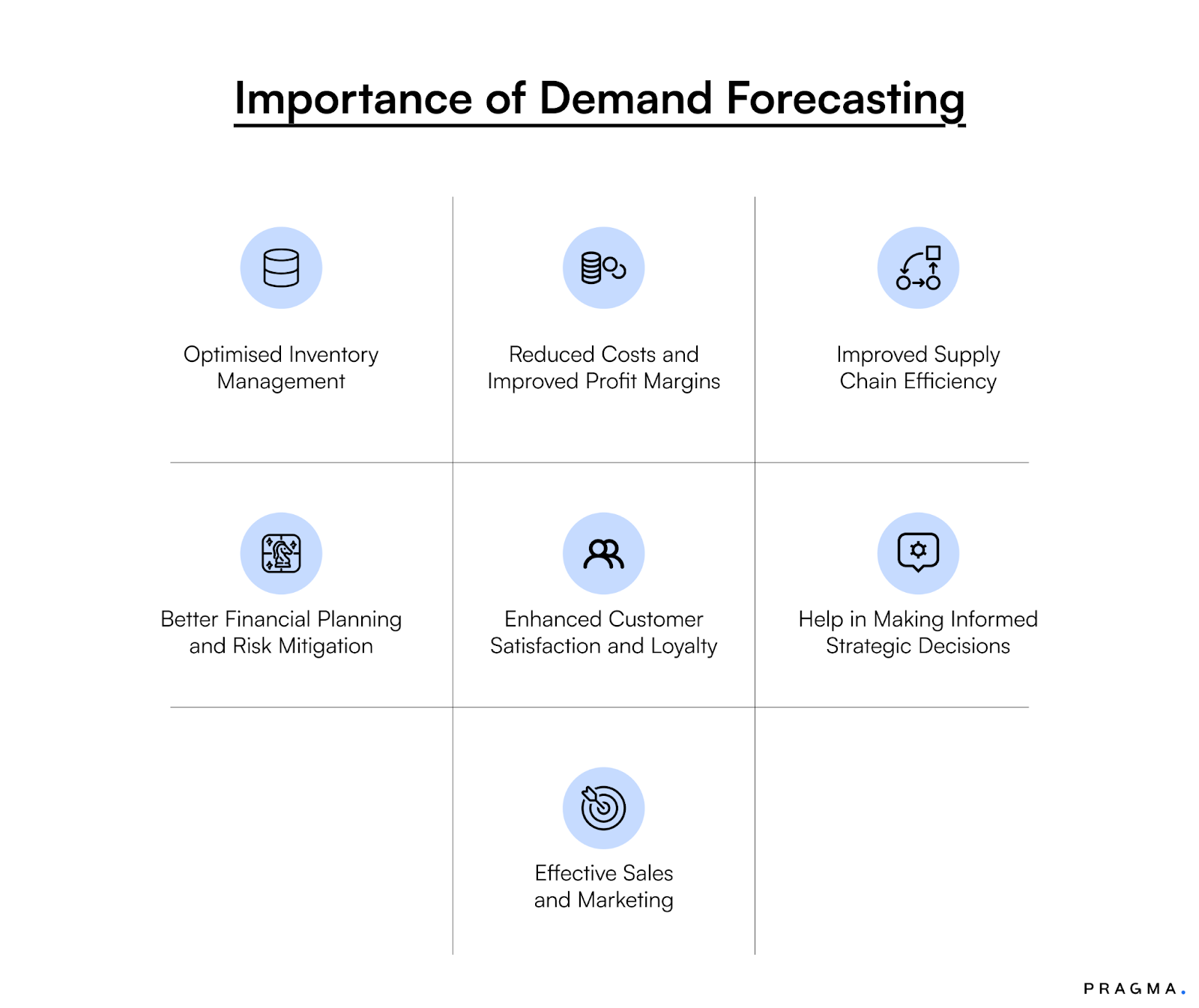Every festive season, we have seen many e-commerce brands run out of stock of essentials just on the second day of sale. This becomes an advantage to their competitors because they have plenty of stock with them, which boosts their sales and profits during the festive season.
On the other hand, we have seen that many sellers stock up so much that it becomes difficult to sell during that time.
This insight states that both the stages—under stock and over stock—are harmful for any e-commerce brand. It is essential for them to know the exact or nearby figures.
And, do you know how it can be achieved? The answer is demand forecasting. With the Indian e-commerce market expected to reach $350 billion/₹29.4 lakh crore by 2030, the importance of demand forecasting also increases.
In this blog, we will look into "The Importance of Demand Forecasting for E-commerce Brands in India".
What Is Demand Forecasting in E-commerce?
Demand forecasting is the process of figuring out how much of each product your customers will want to buy in the future.
It makes use of the past data histories of sales and current inventory patterns to estimate the demand.

How Does Demand Forecasting Actually Work?

Demand forecasting depends upon the following factors, and this tells how it actually works:
The data and information collected from all such factors state the estimated demand numbers.
Let us understand with the help of an example!
Assume that you are a home decor e-commerce brand. Here is how you can take advantage of demand forecasting:
This Diwali season, you are looking for how many diyas and what type of products you should stock up on. For this, you can look for the following:
- You have analysed your past Diwali sales and see that 5000 diyas were sold.
- You went into the market and saw that eco-friendly diyas are more popular among customers.
- External factors tell you Diwali is falling on a weekend this year, which means there is a tendency to shop more.
- Customer behaviour shows people start Diwali shopping 3 weeks before the festival.
Based on the data collected, you might forecast selling 6000-7000 diyas this Diwali season and decide to stock more eco-friendly options.
Why Is Demand Forecasting Important for D2C E-commerce Brands?

Demand forecasting is important for every e-commerce brand. See how it helps the brands:
Optimised Inventory Management
According to a global study, businesses lose $1.77 trillion every year because of inventory problems. Also, in India, many online stores lose 15-25% of their potential sales just because they run out of popular products.
And with the help of good demand forecasting, brands can prevent this. You'll know exactly how much to order - not too little and not too much.
Reduced Costs and Improved Profit Margins
The importance of demand forecasting in reducing costs and improving your profit margins is appreciable. When you know how many products you have to stock up, you will save on storage costs too by avoiding unnecessary piling up.
Do you know, businesses typically spend 25-30% extra every year just storing excess inventory.
Also, when you have too much stock, to clear it up, maybe you have to sell it at a discount to avoid total loss. However, good forecasting can reduce these losses by up to 40%.
Improved Supply Chain Efficiency
According to McKinsey Research, companies that improve their forecasting accuracy by just 10-20% see their inventory costs drop by 5% and revenue increase by 2-3%.
Also, good demand forecasting helps to maintain a smooth supply chain. Here's how it helps:
- When you forecast your demand in advance, you can also communicate this to your supplier, and he can plan accordingly to meet your demand on time.
- They might give you better prices.
- You get priority when supplies are limited.
- You can avoid the costs of emergency orders.
- You might have to pay extra for fast shipping, but if you have to tell your supplier prior, this can be avoided.
This is how demand forecasting is important in the relationship with the supplier, too.
Better Financial Planning and Risk Mitigation
Money management becomes much easier when you know what's coming. Demand forecasting can help in the following situations:
Predicting Your Income:
When you know that you can sell "X" units of a product and will be generating this much income, then you can plan your future tasks too. For example, this helps you decide whether you can afford that new marketing campaign or not.
Managing Cash Flow:
You know when money will come in (from sales) and go out (for inventory)
This prevents situations where you have products to sell but no cash to buy more inventory.
Enhanced Customer Satisfaction and Loyalty
As the customer is everything to any D2C brand, keeping them satisfied and happy is the core weapon to grow your brand. And you definitely know that nothing frustrates more than the "Out os Stock" thing to the customers.
70% of customers who can't find what they want will buy from your competitor instead. And this became a reason for the loss. But when you know the importance of demand forecasting, you will know which products have to be stocked when. Also, when you have the right products in the warehouses, you can deliver faster.
And this makes the customer happy, and they build trust in your brand.
Help in Making Informed Strategic Decisions
With the help of proper demand forecasting, you can make the right decision at the right time. As you know, if the demand for a particular product increases in a particular season, you can stock up on it and increase your sales.
If you say that there is a trend in the market for a particular fashion or thing, you can add it to your inventory.
Effective Sales and Marketing
You can do effective sales and marketing when you know which product to promote and at which time. You can launch or do promotions for a particular product when it has high demand in the market.
This is how the importance of demand forecasting plays a role for every D2C e-commerce brand.
Examples of Demand Forecasting in E-commerce
Let's look at some real-world examples to make this clearer:
Fashion Retailer Success Story
A Mumbai-based online fashion store selling ethnic and western wear.
What's the challenge they were facing?
They were constantly either running out of popular items or stuck with clothes nobody wanted.
Then, what did they do?
They analysed three years of sales data and discovered clear patterns:
- Ethnic wear sales increased by 250% during the wedding season
- Western wear peaked during the college admission season (June-July) and the New Year (December)
- Festive colours (red, gold, maroon) sold 300% more during the Diwali month
- Pastel colours were popular during spring festivals like Holi
And with the help of this demand forecasting, they get amazing results!
- They stocked appropriately for each season.
- Captured 40% more market share during peak wedding season
- Reduced their unsold inventory by 60%
- Their customer satisfaction rating improved from 3.2 to 4.6 out of 5
Challenges of Demand Forecasting in India
Indian D2C e-commerce brands face various challenges due to the unique, complex nature and diversity in the country. See what challenges Indian brands face during demand forecasting:

Diverse Market Conditions
India is a diverse country with different cultures in each state. It can happen that a kurta that's popular in Punjab might not sell in Tamil Nadu because of cultural differences.
So, this diversity becomes one of the challenges for brands to forecast efficiently because what works in one city might completely fail in another.
And the solution to this is that brands should focus on region-specific forecasting models, which will help them to get accurate data according to the place.
"N" Number of Festivals
India has over 50 major festivals, and each affects buying patterns differently.
Festivals are divided into two categories: national and regional. And the sales for different products change according to that.
For example, Diwali affects the entire country but in different ways (sweets in the North, gold in the South), whereas Onam in Kerala boosts traditional wear and home decor sales.
Thus, having this much complexity in festivals makes it difficult for e-commerce brands to predict the right sales.
Economic Volatility
Not everyone in India has the same source of income. Some earn very low amounts, and some earn very well. And this earning can also be influenced by external factors, such as monsoon for the farmers, policy changes, changes in tax, etc.
A recent example this year is the GST changes on textiles; clothing demand patterns shifted significantly.
Rapid Market Changes
Indian people follow trends, and when a new trend comes in, the past data becomes vague, because it makes it difficult for brands to determine how people will respond to a particular trend.
For example, a recent trend for Labubu Dolls came in, and suddenly people started to buy, increasing their demand at such a high rate. But, suddenly, when some people saw it as a negative thing, its demand drastically decreased.
Data Quality Issues
Many brands struggle with incomplete or inconsistent data across different sales channels.
How to Improve Demand Forecasting Accuracy?

Invest in Data Quality
Every brand should focus on collecting the right quality data from all its platforms. Only then can they be able to predict the right number for demand forecasting.
Combine Multiple Methods of Demand Forecasting
Use both quantitative methods and qualitative insights for demand forecasting.
Make Use of Technology
AI and machine learning can identify patterns that humans might miss. Every brand should adopt technology, as these tools can reduce forecasting errors by 20-50%. It will help them to gather the right data.
Focus on Regularly Updating the Data
E-commerce brands should review and adjust forecasts monthly or even weekly during volatile periods.
Collecting Data from Different Departments
Brands should include insights from sales, marketing, and customer service teams in their forecasting process.
Must Take Care of External Factors
Factors like weather forecasts, economic indicators, and social media trends should be considered properly.
Why Demand Forecasting Is a Competitive Advantage in E-commerce- Benefits of Demand Forecasting
- It helps to predict customer demand accurately.
- It prevents overstocking and stockouts.
- Improves cash flow management in the business
- It helps to reduce storage and warehouse costs.
- It ensures timely product availability to the customers.
- Helps in increasing customer satisfaction and loyalty.
- Helps plan seasonal sales and promotions.
- It helps brands to make smarter marketing and pricing decisions.
- It also strengthens coordination with suppliers.
- It reduces product wastage and returns.
To Wrap It Up
Thus, to conclude here, we want to say that demand forecasting is not an option; it is necessary for every D2C e-commerce brand to do it.
With the market being volatile and growing, brands that can predict and meet customer demand will be on top of the competitors.
And the importance of demand forecasting is clear; it helps in reducing costs, increasing customer satisfaction and increasing profits. And this is what every brand needs.

FAQs (Frequently Asked Questions On The Importance of Demand Forecasting for E-commerce Brands in India)
1. What exactly is demand forecasting in e-commerce?
Demand forecasting is the process of estimating future customer demand for each product or SKU over a certain period, using historical sales data, trends, seasonality, external factors, and predictive models.
2. Why is demand forecasting so important for e-commerce brands?
It offers multiple benefits:
- Helps achieve optimal stock levels — avoiding both overstock and stockouts.
- Reduces holding costs and waste.
- Improves customer satisfaction by ensuring products are available when needed.
- Informs marketing, financial planning, and resource allocation.
- Helps manage risk and respond to market fluctuations and trends.
3. What are the main methods or types of demand forecasting used by e-commerce brands?
Some common types and methods include:
- Time series models (e.g. ARIMA) analysing past performance.
- Regression / causal models that account for external factors (promotions, season, macro trends).
- Qualitative methods (expert opinion, market surveys) useful for new products or markets.
- Machine learning / AI models which adapt dynamically and incorporate many data signals.
- Demand sensing (real-time input data) to correct short-term deviations from baseline forecasts.
4. What challenges do Indian e-commerce brands face in demand forecasting?
Some challenges are:
- Volatile consumer behaviour and seasonal spikes (festivals, sales) making patterns non-linear.
- Incomplete or noisy historical data, especially for newer brands.
- External disruptions (logistics delays, supply chain disruptions, promotions) altering demand abruptly.
- Over-reliance on models without human oversight and domain context.
- Complexity in combining multiple forecasting methods and signals.
5. Can you share real examples where demand forecasting helped Indian brands?
Yes — for instance, academic studies in India show time series models like ARIMA, TBATS, neural network approaches being used to forecast demand in Indian e-commerce platforms to manage inventory and reduce shortfalls.
Also, practical guides note that brands using demand forecasts better align inventory during festivals, avoiding stockouts or excess.
6. How do you measure demand forecast accuracy?
Key metrics include:
- Mean Absolute Percentage Error (MAPE)
- Mean Absolute Error (MAE)
- Root Mean Square Error (RMSE)
- Tracking bias (over-forecasting or under-forecasting)
You compare forecasted sales vs actual sales over time and refine the models accordingly.
7. How can demand forecasting be improved over time?
Best practices include:
- Combine multiple forecasting methods (ensemble).
- Adjust models with new data frequently (rolling forecasts).
- Incorporate external data (promotions, competitor activity, macro trends).
- Segment forecasts by geography, SKU, channel rather than one big forecast.
- Use automation and AI to detect anomalies and recalibrate.
- Human oversight: domain knowledge should adjust for events models miss
Talk to our experts for a customised solution that can maximise your sales funnel
Book a demo


.png)
.webp)
.png)